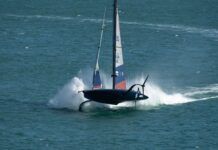
Go round any boat show and look at the hulls from underneath—most now have a narrow, very pointed bow and a broad flat stern. Why? Where did this come from and what are the advantages and disadvantages of this shape compared to more traditional designs for cruising boats?
To continue reading this article or issue you must be a paid subscriber. Sign in
Subscribe to Practical Sailor
Get full access to Practical Sailor - over 4,000 articles - for just $34.
Subscribe today and save 42% off the annual rate.









































Your discussion of slamming needs more caveats. A big consideration is the wave height and period as compared to the length of the vessel. Next, many flat, shallow hulls have chines so as the vessel heels the chine contributes more bouancy, preventing the rail from going into the water. My BO 35.1 rides fine, though I primarily sail in the Chesapeake Bay.